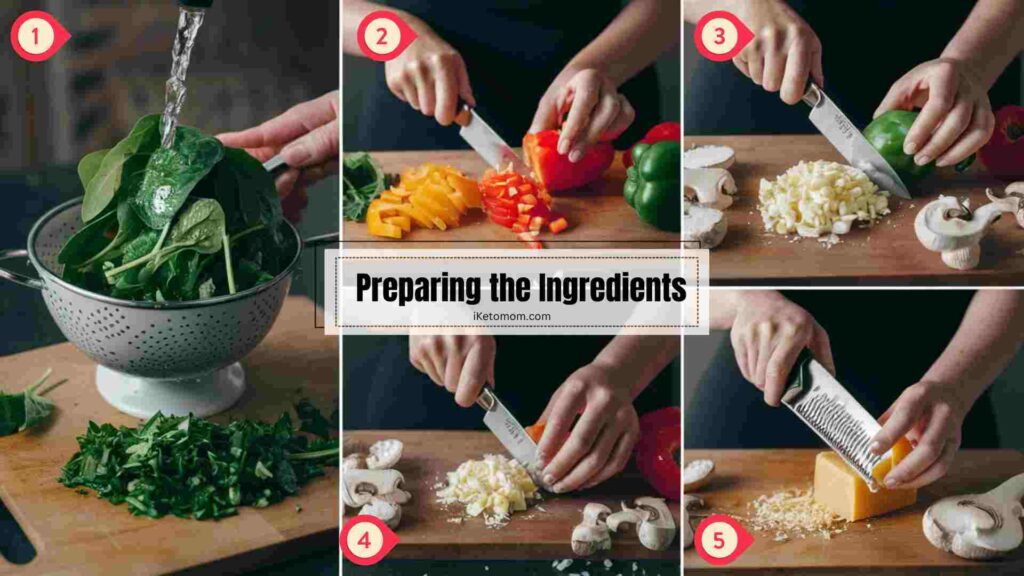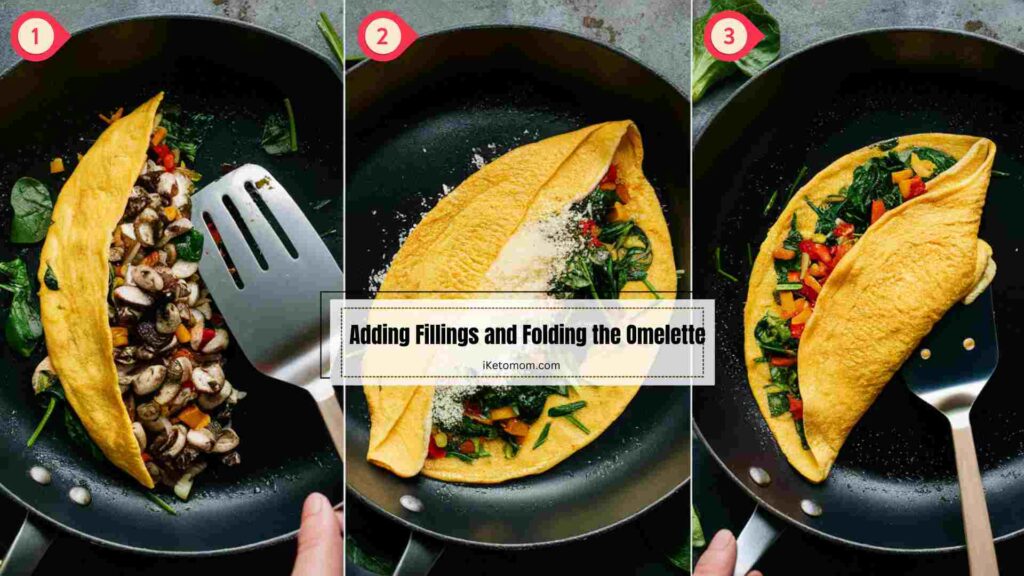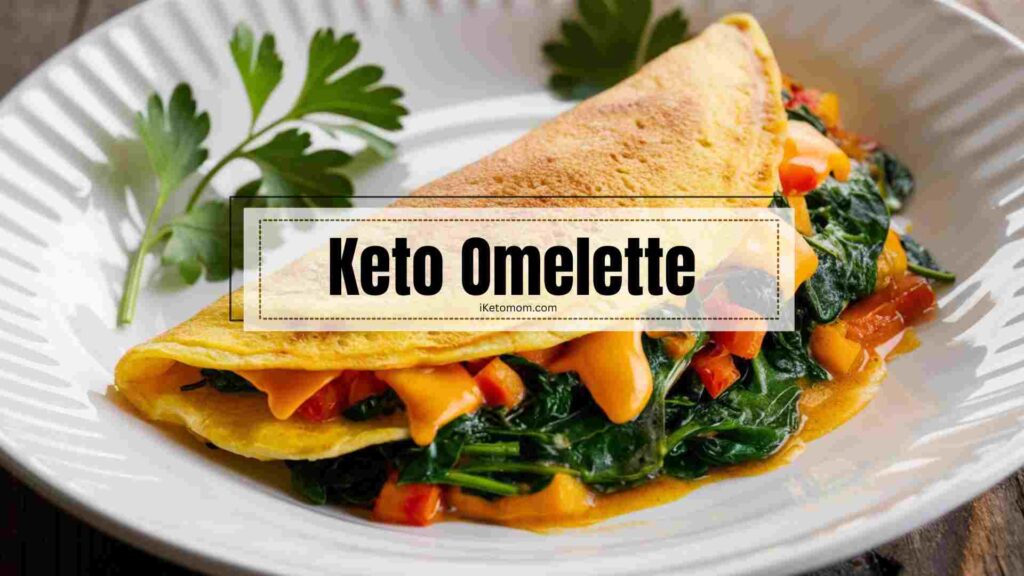A Keto Omelette is a low-carbohydrate, high-fat dish that aligns with the principles of a ketogenic diet. It typically consists of eggs cooked with Keto-friendly ingredients such as vegetables, cheese, and healthy fats like butter or avocado oil. The emphasis is on reducing carbs while increasing healthy fats and moderate protein intake.
Omelettes are popular in Keto diets for several reasons. Firstly, eggs are a staple in Keto meal plans due to their high protein content and minimal carbs. Secondly, omelettes provide versatility, allowing for a variety of fillings such as low-carb vegetables and Keto-approved cheeses. This versatility makes it easy to create satisfying meals while staying within Keto guidelines. Additionally, omelettes are quick and simple to prepare, making them suitable for busy individuals following a Keto lifestyle.
Keto White Chicken Chili Recipe
Ingredients
1. Eggs (Primary Ingredient)
Eggs are the foundation of a Keto Omelette, providing protein, healthy fats, and essential nutrients. Use fresh, high-quality eggs for the best flavor and nutrition. Typically, two large eggs are used for one serving of Keto Omelette.
2. Keto-Friendly Vegetables
- Spinach: Rich in vitamins and minerals, spinach adds a nutrient boost to the omelette while keeping it low in carbs.
- Mushrooms: With a meaty texture and earthy flavor, mushrooms are a flavorful addition to Keto Omelettes.
- Bell Peppers: Colorful and crunchy, bell peppers are low in carbs and high in antioxidants, enhancing both taste and nutrition.
3. Keto-Approved Cheese
- Cheddar: Sharp and savory, cheddar cheese melts beautifully and adds richness to the omelette.
- Feta: Tangy and crumbly, feta cheese offers a distinct flavor that pairs well with vegetables and herbs.
- Goat Cheese: Creamy and mild, goat cheese adds a luxurious texture to the omelette.
4. Healthy Fats
- Butter: Adds richness and flavor to the omelette. Choose grass-fed butter for added nutritional benefits.
- Avocado Oil: A heart-healthy oil with a mild flavor, avocado oil is ideal for cooking the omelette at higher temperatures.
- Coconut Oil: Provides a subtle coconut aroma and is suitable for those following a Keto or paleo diet.
5. Seasonings and Herbs
- Salt and Pepper: Basic seasonings to enhance flavor.
- Garlic Powder: Adds a hint of garlic flavor without the carbs.
- Parsley (or other herbs): Fresh herbs like parsley, chives, or basil add brightness and freshness to the omelette.
Elevate your Keto Omelette with these carefully selected ingredients, ensuring a flavorful, nutrient-rich, and satisfying meal that perfectly aligns with your ketogenic lifestyle.
Instructions
1. Preparing the Ingredients
- Wash and chop Keto-friendly vegetables such as spinach, mushrooms, and bell peppers into small pieces.
- Grate Keto-approved cheese like cheddar, feta, or goat cheese if using.
2. Whisking the Eggs and Adding Seasonings
- In a bowl, crack two large eggs and whisk them until well beaten.
- Season the beaten eggs with a pinch of salt, a dash of pepper, and optionally, 1/4 teaspoon of garlic powder. Mix well.
3. Cooking the Omelette Base in a Non-Stick Skillet
- Heat a non-stick skillet over medium heat and add 1 tablespoon of butter, avocado oil, or coconut oil.
- Pour the whisked eggs into the skillet, tilting the pan to spread the eggs evenly.
- Cook the eggs for 2-3 minutes or until the edges start to set and the bottom is lightly golden.
4. Adding Fillings and Folding the Omelette
- Sprinkle the chopped vegetables and grated cheese on one half of the omelette.
- Using a spatula, gently fold the other half of the omelette over the fillings, creating a half-moon shape.
- Press down lightly with the spatula to seal the edges and ensure even cooking.
5. Cooking Until Golden Brown and Firm
- Continue cooking the omelette for another 2-3 minutes or until the bottom is golden brown and the omelette is firm but still slightly moist on top.
- Carefully flip the omelette using the spatula and cook for an additional 1-2 minutes on the other side until fully cooked and golden brown.
- Slide the cooked omelette onto a plate, garnish with fresh herbs like parsley if desired, and serve hot.
These detailed instructions ensure that your Keto Omelette turns out perfectly every time. By preparing the ingredients thoughtfully, whisking the eggs with the right seasonings, and cooking the omelette on a non-stick skillet, you set the stage for a flavorful and satisfying dish. Adding the fillings and folding the omelette with care ensures even distribution of flavors, while cooking until golden brown and firm results in a beautifully cooked omelette with a delightful texture. These steps, when followed attentively, guarantee a delicious Keto Omelette that’s sure to be a hit at any mealtime.
A Keto Omelette is a delicious and nutritious dish that fits perfectly into a ketogenic diet, which is characterized by low carbohydrate intake and high fat consumption. The primary ingredients of a Keto Omelette typically include eggs, Keto-friendly vegetables, Keto-approved cheese, healthy fats, and seasonings.
One of the main reasons why Keto Omelettes are popular is because they are versatile and customizable. You can choose from a variety of low-carb vegetables such as spinach, mushrooms, and bell peppers to add flavor, texture, and nutrients to your omelette. Keto-approved cheeses like cheddar, feta, or goat cheese provide richness and creaminess without adding excessive carbs.
Keto Omelette Nutrition Info
Here’s a nutrition table for a basic Keto Omelette made with the ingredients mentioned earlier:
| Nutrient | Amount per Serving |
|---|---|
| Calories | Approximately 360-400 |
| Total Fat | 30-35 grams |
| Saturated Fat | 13-15 grams |
| Cholesterol | 385-400 milligrams |
| Sodium | 600-650 milligrams |
| Total Carbohydrates | 3-5 grams |
| Dietary Fiber | 1-2 grams |
| Sugars | 2-3 grams |
| Protein | 17-20 grams |
| Vitamin A | 15-20% of DV |
| Vitamin C | 25-30% of DV |
| Calcium | 15-20% of DV |
| Iron | 10-15% of DV |
Please note that these values are approximate and can vary based on the specific ingredients and quantities used in the Keto Omelette. Adjustments may be needed based on your recipe and portion size.
Here’s the combined nutrition table for each ingredient used in a keto omelette:
| Ingredient | Serving Size | Calories | Protein | Total Fat | Saturated Fat | Cholesterol | Carbohydrates | Fiber | Sugars | Sodium | Potassium |
|---|---|---|---|---|---|---|---|---|---|---|---|
| Eggs | 1 large (50g) | 70 kcal | 6 g | 5 g | 1.6 g | 186 mg | 0.6 g | 0 g | 0.5 g | 70 mg | 69 mg |
| Cheddar Cheese | 1 oz (28g) | 110 kcal | 7 g | 9 g | 5 g | 30 mg | 1 g | 0 g | 0 g | 180 mg | 28 mg |
| Butter | 1 tbsp (14g) | 102 kcal | 0.1 g | 12 g | 7 g | 31 mg | 0 g | 0 g | 0 g | 2 mg | 3 mg |
| Spinach | 1 cup (30g) | 7 kcal | 0.9 g | 0.1 g | 0 g | 0 mg | 1.1 g | 0.7 g | 0.1 g | 24 mg | 167 mg |
| Mushrooms | 1 cup (70g) | 15 kcal | 2.2 g | 0.2 g | 0 g | 0 mg | 2.3 g | 1 g | 1.4 g | 4 mg | 223 mg |
| Bell Peppers | 1 medium (119g) | 24 kcal | 1 g | 0.2 g | 0 g | 0 mg | 5.5 g | 1.7 g | 2.7 g | 2 mg | 211 mg |
| Heavy Cream | 1 tbsp (15g) | 52 kcal | 0.4 g | 5.6 g | 3.5 g | 21 mg | 0.4 g | 0 g | 0.4 g | 6 mg | 7 mg |
This table provides a clear overview of the nutritional content for each ingredient used in a keto omelette.
Tips for Best Results 🍽
Creating a perfect keto omelette involves attention to detail, quality ingredients, and proper technique. Here are some comprehensive tips to ensure the best results:
- Use quality eggs: Start with fresh, high-quality eggs. The freshness of the eggs can significantly impact the taste and texture of your omelette.
- Add healthy fats: Since the keto diet emphasizes high fat intake, consider adding healthy fats like avocado oil, coconut oil, or butter to your pan before cooking the omelette. This not only enhances the flavor but also helps keep you satiated.
- Incorporate low-carb vegetables: Load up your omelette with low-carb vegetables like spinach, bell peppers, mushrooms, onions, and tomatoes. These add flavor, texture, and essential nutrients without adding too many carbs.
- Choose the right cheese: Opt for full-fat cheeses like cheddar, mozzarella, or feta. Cheese adds richness and creaminess to the omelette while keeping it low in carbs.
- Season well: Don’t skimp on seasoning. Use salt, pepper, and other herbs and spices like basil, oregano, or paprika to enhance the flavor of your omelette.
- Don’t overcook: Cook the omelette over medium heat and avoid overcooking it. A slightly runny or creamy center is preferable for a perfect omelette texture.
- Experiment with fillings: Get creative with your omelette fillings. Try different combinations of meats, cheeses, and vegetables to keep things interesting and flavorful.
- Fold carefully: When folding the omelette, do it gently to avoid breaking it apart. Use a spatula to fold it in half or thirds, depending on your preference.
- Serve with keto-friendly sides: Pair your omelette with keto-friendly sides like avocado slices, bacon, or a side salad dressed with olive oil and vinegar.
- Practice makes perfect: Like any cooking skill, making the perfect omelette takes practice. Don’t be discouraged if your first few attempts aren’t flawless. Keep experimenting and refining your technique until you find what works best for you.

Keto Omelette Recipe
Equipment
- Non-stick skillet or frying pan A non-stick skillet is essential for cooking the omelette without it sticking to the pan. Choose a size that suits the number of eggs you're using
- Whisk or Fork You'll need a whisk or fork to beat the eggs and combine them with the seasonings before cooking.
- Cutting board and knife These are needed for chopping any vegetables or other fillings you plan to add to the omelette.
- Spatula A spatula is handy for flipping and folding the omelette while it's cooking.
- Grater (if using cheese) If you're using cheese that needs grating, such as cheddar or Parmesan, you'll need a grater.
- Measuring spoons (optional) If you're measuring out specific amounts of seasonings or herbs, measuring spoons can be helpful.
- Stove or cooktop You'll need a heat source such as a stove or cooktop to cook the omelette.
- Serving plate A plate for serving the finished omelette.
Ingredients
- 2 Large Eggs
- ¼ Cup Chopped vegetables (such as spinach, mushrooms, bell peppers)
- ¼ Cup Shredded Keto-friendly cheese (like cheddar, feta, or goat cheese)
- 1 Tablespoon Butter or Avocado oil
- Salt and pepper to taste
Optional
- ¼ Teaspoon Garlic Powder
- Fresh herbs (such as parsley) for garnish
Instructions
- Prepare ingredients:
- Chop vegetables and grate cheese as needed.
- Whisk eggs:
- Beat eggs in a bowl and add salt, pepper, and optional garlic powder.
- Cook base:
- Heat butter in a non-stick skillet, pour in egg mixture, and cook until edges set.
- Add fillings:
- Sprinkle vegetables and cheese on one half of the omelette, then fold the other half over.
- Cook until done:
- Cook until the omelette is golden brown and set, then serve hot.
Notes
Delicious Topping Ideas
ere are some delicious keto-friendly topping ideas to take your omelette to the next level:
1. Avocado
Sliced or mashed avocado adds creaminess and healthy fats to your omelette. Plus, it pairs perfectly with eggs.
2. Salsa
Opt for a homemade or store-bought salsa with no added sugars. The combination of tomatoes, onions, peppers, and spices adds a burst of flavor and freshness.
3. Sour cream
A dollop of sour cream adds richness and tanginess to your omelette. Look for full-fat sour cream to keep it keto-friendly.
4. Bacon
Crumbled bacon is a classic omelette topping that adds a savory, crispy texture. It’s also a great way to incorporate more protein and fat into your meal.
5. Smoked salmon
For a touch of elegance, top your omelette with slices of smoked salmon. It adds a luxurious flavor and pairs well with eggs and cream cheese.
6. Sauteed mushrooms
Cooked mushrooms are a delicious addition to omelettes, adding earthy flavor and meaty texture. Saute them in butter or olive oil before adding them to your omelette.
7. Spinach
Fresh spinach leaves wilt quickly when added to a hot omelette, providing a nutritious boost of vitamins and minerals without adding many carbs.
8. Cheese
While cheese can also be incorporated inside the omelette, adding a sprinkle of shredded cheese on top before serving adds extra gooeyness and flavor.
9. Chives or green onions
Finely chopped chives or green onions add a pop of color and mild onion flavor to your omelette. They’re also great for garnishing.
10. Hot sauce or chili flakes
If you like a bit of heat, drizzle some hot sauce or sprinkle chili flakes over your omelette for an added kick.
Feel free to mix and match these toppings based on your preferences and dietary needs. With these ideas, you can create endless variations of delicious keto omelettes!
FAQ
Are omelettes keto-friendly?
Yes, omelettes are generally considered keto-friendly. They are primarily made from eggs, which are low in carbohydrates and high in protein and healthy fats, making them an excellent choice for those following a ketogenic diet. Additionally, omelettes can be customized with keto-friendly ingredients such as cheese, vegetables, and meats, allowing for a delicious and satisfying meal that aligns with keto principles. However, it’s essential to be mindful of the ingredients you add to your omelette to ensure they fit within your daily carb limit while providing the necessary nutrients for a well-rounded meal.
What makes a keto omelette different from a regular omelette?
A keto omelette differs from a regular omelette primarily in the choice of ingredients used. While a traditional omelette may include a variety of fillings such as ham, cheese, onions, and bell peppers, a keto omelette focuses on ingredients that are low in carbohydrates and high in healthy fats, which are key principles of the ketogenic diet.
Here are some key differences between a keto omelette and a regular omelette:
- Ingredients: Keto omelettes typically include ingredients that are low in carbs and high in healthy fats, such as avocado, cheese, bacon, sausage, spinach, mushrooms, and other low-carb vegetables. These ingredients help keep the omelette’s carb count low while providing essential nutrients and helping you stay in ketosis.
- Fat content: Keto omelettes often contain a higher fat content compared to regular omelettes. This can be achieved by using ingredients like full-fat cheese, butter, coconut oil, or avocado oil in the cooking process.
- Carb count: While traditional omelettes may include ingredients like onions, tomatoes, and bell peppers, which can be higher in carbohydrates, keto omelettes tend to use lower-carb alternatives or smaller portions of these ingredients to keep the carb count within keto-friendly limits.
- Nutritional goals: Keto omelettes are tailored to meet the macronutrient ratios of the ketogenic diet, which typically consists of high fat, moderate protein, and low carbohydrates. Regular omelettes may not necessarily adhere to these specific nutritional goals.
Overall, the main difference between a keto omelette and a regular omelette lies in the selection of ingredients to ensure that the keto omelette supports ketosis and aligns with the principles of the ketogenic diet.
How many carbs are in a keto omelette?
The number of carbs in a keto omelette can vary depending on the ingredients used. A basic keto omelette made with eggs, cheese, and low-carb vegetables like spinach or bell peppers typically contains around 2-4 grams of carbohydrates per serving. However, adding higher-carb ingredients like onions or tomatoes may increase the carb count slightly. It’s important to be mindful of the carb content of the ingredients you choose to ensure your omelette stays within your desired carb intake on a ketogenic diet.
Can I have ketchup with my keto omelette?
Traditional ketchup is often high in sugar and carbohydrates, which makes it unsuitable for a keto diet. However, there are sugar-free and low-carb ketchup alternatives available that you can enjoy in moderation with your keto omelette. These alternatives are typically sweetened with artificial sweeteners or natural low-carb sweeteners like stevia or erythritol, making them a better option for those following a ketogenic lifestyle. Just be sure to check the label for the carb content and ingredients to ensure it fits within your dietary preferences and goals.
What’s the best way to fold a Keto Omelette?
The best way to fold a Keto Omelette depends on personal preference and the desired presentation. Here are three common folding techniques for Keto Omelettes:
- Half-Moon Fold: This is the classic and simplest way to fold an omelette.
- Once the omelette is cooked on one side, sprinkle the fillings on one half of the omelette.
- Using a spatula, gently fold the other half of the omelette over the fillings, creating a half-moon shape.
- Press down lightly with the spatula to seal the edges and ensure even cooking of the fillings.
- Tri-Fold Fold: This technique creates a neat and compact omelette with three layers.
- Similar to the half-moon fold, sprinkle the fillings on one half of the cooked omelette.
- Fold one-third of the omelette over the fillings using a spatula, then fold the other third over the first fold, creating a tri-fold or letter-fold shape.
- Press down lightly to seal the edges and compact the omelette.
- Roll-Up Fold: This technique is ideal for omelettes with longer fillings or when you want a rolled presentation.
- Spread the fillings evenly over the entire cooked omelette.
- Starting from one edge, gently roll the omelette into a tight cylinder shape, using the spatula to assist in rolling.
- Place the rolled omelette seam-side down on the plate for a neat presentation.
Ultimately, the best way to fold a Keto Omelette is the method that suits your preferences and the fillings you’re using. Experiment with different folding techniques to find the one that works best for you in terms of taste, texture, and presentation.

I’m Priscilla Swahn, a registered dietitian with a master’s degree in nutritional sciences. With over a decade of experience in holistic nutrition, I specialize in creating delicious keto recipes to help you enjoy a healthy lifestyle. On iKetoMom, you’ll find a variety of recipes for every meal—hearty breakfasts, satisfying lunches, mouthwatering dinners, indulgent desserts, and refreshing drinks. My recipes make keto living easy and enjoyable for the whole family. Featured in EatingWell and MindBodyGreen, I also collaborate with health centers and corporate companies to share my expertise. Join me and discover the joy of keto cooking!







